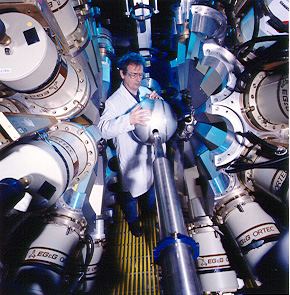


At the heart of the gammasphere is this aluminum sphere. |
Argonne's newest instrument
is expanding the limits of what is known about the structure of the atomic nucleus. The $20 million gamma-ray "microscope" is designed to help answer fundamental questions about the structure and behavior of atomic nuclei - especially those containing large excesses of protons and neutrons. |
Nuclei, some of the most basic building blocks of creation, are found the core of every atom in the universe. Understanding their complex structure and mechanics provides clues to how and why the universe is as it is and behaves as it does.
The 12-ton gamma-ray detector saw its first beam from the Argonne Tandem Linear Accelerator System (ATLAS) on Jan. 16. Most experiments will involve sending a beam of ions (atoms with one or more electrons stripped away) into a thin target at the center of Gammasphere. Some of the ions' nuclei fuse with those in the target, creating new, heavier nuclei.
"The device is incredibly powerful," said Kim Lister (PHY). "The first test was a standard reaction, an oxygen beam on a nickel target. Even so, after 10 minutes of running, we could see new nuclear states that had never been seen before." One of the first experiments resulted in new data on a phenomenon called"isospin symmetry."

Argonne scientist Kim Lister installs the target chamber at the heart of Gammasphere. |
The 10-foot-tall device is a silvery machined metal sphere about seven feet in diameter pierced by 116 holes. Yard-long detectors fit through the holes. Their blunted tips converge near the center of the sphere. The detectors must be cooled to -320 F (-196 C) with liquid nitrogen to operate properly. |
Gammasphere's 108 single-crystal detectors, cylinders of high-purity germanium about the size of a coffee cup, intercept the gamma rays given off by nuclei created when ATLAS beams strike targets of various materials. (Previously, physicists used one such detector and moved it around the target over a period of days to gather a full picture of gamma-ray emissions.)
|
The nuclei fly on for another 30 feet through another detector called the Fragment Mass Analyzer (FMA), which measures their mass and records their eventual decay. The sensitive combination of Gammasphere and FMA is able to pick out one interesting nucleus from a "background" of 10,000,000 less interesting ones. Although the device has only been in operation for a short time, physicists already are planning to upgrade the Gammasphere-FMA detector system. |

The fully assembled Gammasphere, with the Fragment Mass Analyzer (yellow) in the background. |
First on the agenda is the "Microball," a spherical detector about the size of a basketball that will nestle in Gammasphere's central cavity. Microball will intercept charged particles and provide a "factor of 10 improvement" over the current arrangement, Lister said. The FMA will be fitted with silicon detectors that will enable physicists to probe the nuclear behavior of the heaviest elements, and may provide hints at what lies beyond the known periodic table.